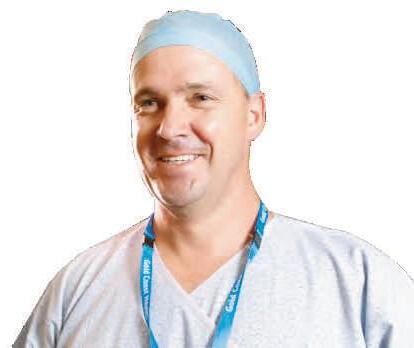
3 minute read
The big M: Menopause
MENOPAUSE IS A NATURAL CHANGE IN THE LIFE OF EVERY WOMAN, BUT MANY FEEL UNCERTAIN AND UNEASY ABOUT ‘THE CHANGE’ - WHAT IT IS, WHAT HAPPENS AND WHAT CAN BE DONE TO RELIEVE SYMPTOMS.
Put simply, menopause is the end of the reproductive stage of a woman’s life. The ovaries stop releasing eggs and monthly periods cease.
Advertisement
There are in fact three stages to menopause:
- Perimenopause (stage before menopause, when periods become irregular, lasting generally between 4 and 6 years)
- Menopause (when your periods cease for 12 months and
- Postmenopause (when reproduction ceases and your body adjusts to operating with lower hormone levels)
Generally women experience menopause between 45 and 60 years of age, but some women, around 12 percent, will experience early menopause (when menopause begins before 45), and this can be due to a number of reasons including some cancer treatments.
Like most things, menopause is not a ‘one size fits all’ situation. Across the different stages of menopause and as oestrogen levels decrease, women experience a whole range of symptoms, and to varying degrees, some symptoms may be severe and some very mild.
Commonly women experience hot flushes, aches and pains, insomnia (difficulty sleeping), lethargy, mood changes and vaginal and urinary changes.
It is not uncommon for these changes to begin to occur in the perimenopause stage.
The good news is there are plenty of treatment options available to ease symptoms.
Menopausal Hormone Therapy (MHT) is one of the more well known forms of treatment for menopause symptoms. It works by replacing the hormones that are depleting within the body such as oestrogen and progesterone, in order to relieve symptoms. It often works well on hot flushes, insomnia, mood changes, joint aches and vaginal dryness.
However, this form of treatment cannot be used by all women, in particular those who have had a cancer diagnosis such as breast or uterine cancer.
If MHT is not an option, non-hormonal medicines can also be prescribed. Some antidepressant medications have shown to be effective at treating hot flushes and night sweats.
Another non-hormonal option to manage vaginal and urinary changes is Vaginal Laser with the Juliet Erbium YAG Laser that Dr Cary offers as an in-office procedure.
Many women also find natural and alternate therapies such as acupuncture, meditation/ mindfulness practices and herbal remedies helpful in managing symptoms. Health and lifestyle choices are also important factors for women to consider, especially giving up smoking, weight management and taking time for regular exercise.
Dr Andrew Cary is an obstetrician, gynecologist and IVF specialist with over 30 years experience in caring for Gold Coast women| drcary.com.au


DEATHS DUE TO ISCHAEMIC HEART CONDITIONS HAVE BEEN INCREASING ACROSS AUSTRALIA IN RECENT YEARS, BUT WHAT IS BEHIND THE INCREASE AND WHAT CAN YOU DO TO PROTECT YOURSELF?

Heart disease has long been a leading cause of death for Australians, but recently, deaths due to ischaemic heart disease have increased beyond the expected natural range, according to a report from the Actuaries Institute.
The American Heart Association describes ischaemia as a condition in which blood flow is restricted or reduced in a part of the body. In cardiac ischemia blood flow and oxygen is restricted to the heart muscle, often by narrowed coronary arteries. This restriction then increases the chance of heart attack.
The Actuaries Institute reported that during 2021 and 2022 there were around 2,300 deaths due to cardiac ischemia beyond the general expectation, a finding also supported by the Australian Bureau of Statistics.
Fatalities could be increasing due to a number of factors, the pandemic being one of them.
During Covid-19 lock downs, and throughout the pandemic, people visited their GP less, which meant symptoms and risk factors were picked up later, when cardiac disease was more advanced.
Covid-19 itself causes inflammation in the body, and this coupled with other pre-existing conditions and poorer lifestyle choices (especially during lockdowns) means the effects of cardiac issues have been magnified in many people, unbeknownst to them, leading to an increase in serious cardiac incidents and death.
“It is very important that people visit their GP regularly and make their heart health a regular part of their check-ups,” said Dr Ben Andersen, a leading Gold Coast cardiothoracic surgeon.
“Cardiac issues can often be managed effectively with early diagnosis, and when people are aware of their risk factors they can make some relatively simple changes in lifestyle that make all the difference.” heartsurgerygoldcoast.com au
Risk factors that can increase your chances of heart disease, including cardiac ischaemia, are issues with weight, such as obesity, smoking (including vaping), diabetes, high blood pressure, high cholesterol and a family history of heart disease and other coronary issues, among others; all of which should be carefully managed with your healthcare professional.
The good news is, since the end of the pandemic, more people have started heading back to their doctors and heart health checks have been increasing since the end of 2022 according to Medicare.
A heart health check only takes around 20 minutes and includes some simple tests such as a blood pressure check, blood test and discussion around family history and risk factors.
Dr Ben Anderson MBBS BMedsci FRACS
VMO at John Flynn and Pindara Private hospitals, The Tweed Hospital and consulting at Goonellabah Medical Centre.











